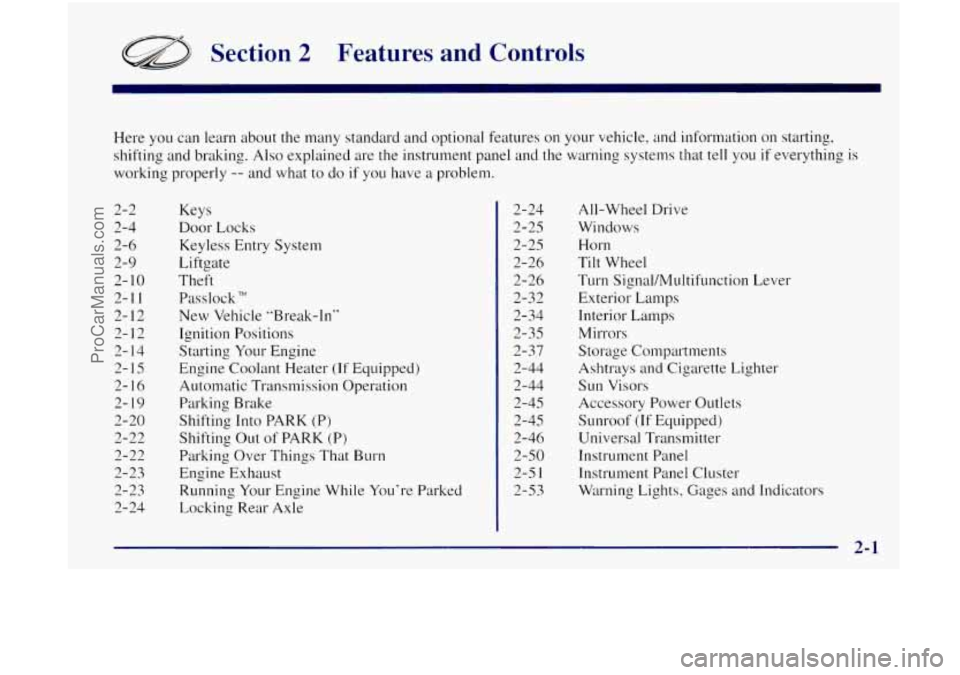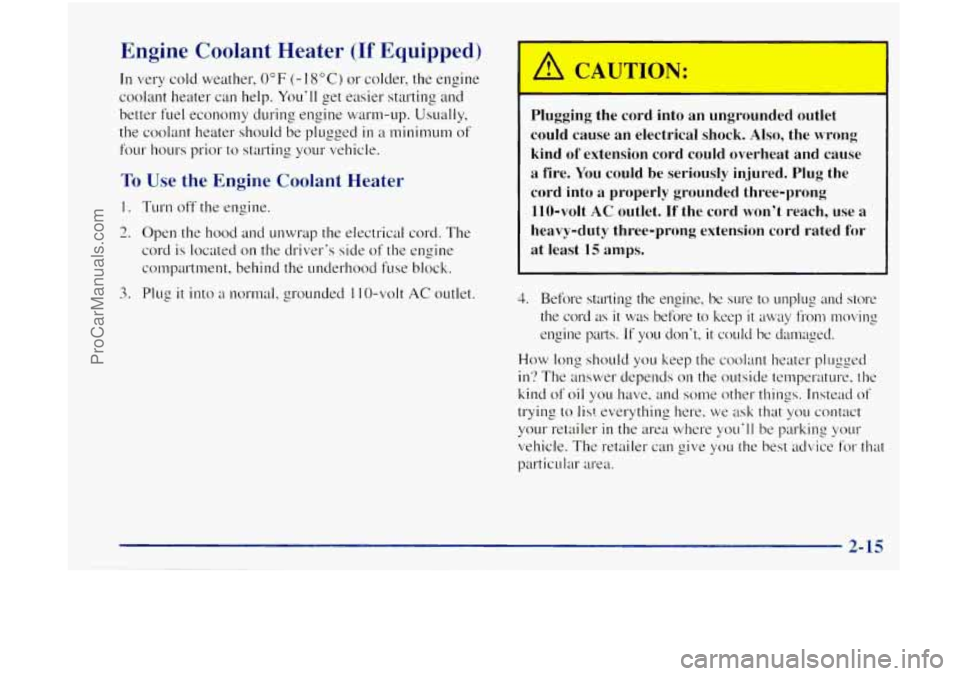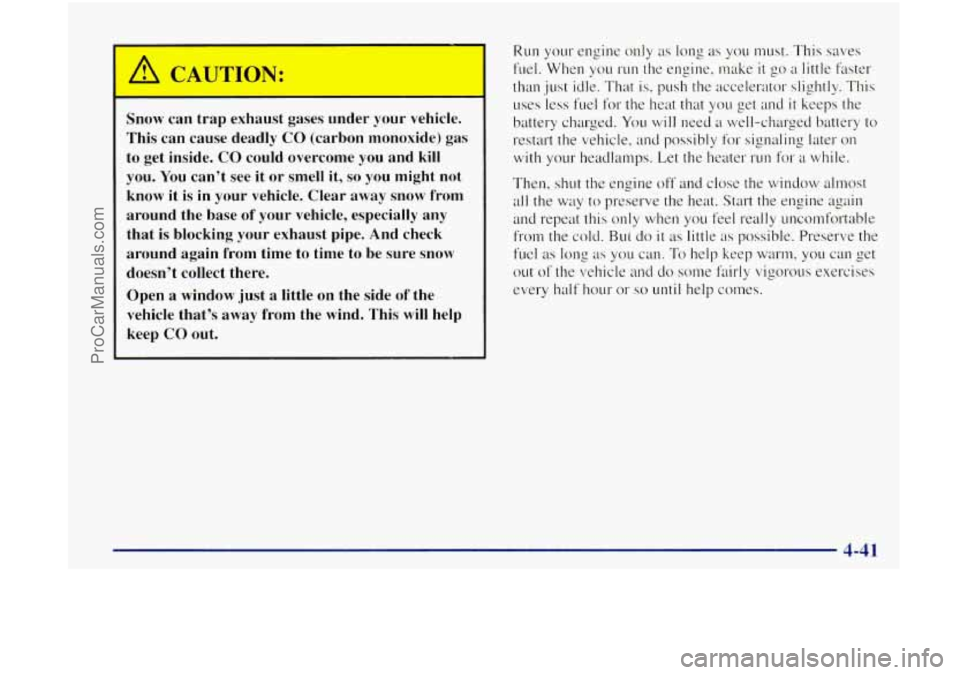heater OLDSMOBILE BRAVADA 1998 Owners Manual
[x] Cancel search | Manufacturer: OLDSMOBILE, Model Year: 1998, Model line: BRAVADA, Model: OLDSMOBILE BRAVADA 1998Pages: 380, PDF Size: 19.2 MB
Page 15 of 380

Horizontal Control: Raise the front of the seat by
raising the forward edge of
the button. Lower the front
of the seat by lowering the forward edge of the button.
Move the seat forward by moving the whole button
toward the front
of the vehicle.
Raise the rear of the seat by raising
the rear edge of the
button. Lower the rear of the seat by lowering the rear
edge of the button. Move the seat rearward by moving
the whole button toward
the rear of the vehicle.
Moving the whole button up or down raises or lowers
the whole seat.
Vertical Control: Move the reclining front seatback
rearward by moving the button toward the rear
of the
vehicle. Move the seatback forward by moving the
button toward the front of the vehicle.
Heated Front Seats (Option)
If you have this feature,
the control is located on
the side of the seat. This
feature
will quickly heat
the lower cushion and
lower back of the driver
and front passenger seats
for added comfort.
Press the lower part
of the switch down to turn the
heater on low. Press the upper part of
the switch to turn
the heater on high. Put the switch
in the center position
to turn the heater off.
ProCarManuals.com
Page 65 of 380

a Section 2 Features and Controls
Here you can learn about the many standard and optional features on your vehicle, and information on starting,
shifting and braking. Also explained are
the instrument panel and the warning systems that tell you if everything is
working properly
-- and what to do if you have a problem.
2-2
2-4
2-6
2-9
2-
10
2-1 1
2- 12 2- 12
2- 14
2- 15
2-16
2- 19
2-20
2-22
2-22
2-23
2-23
2- 24 Keys
Door Locks
Keyless Entry System
Liftgate
Theft Passlock
TM
New Vehicle “Break-In”
Ignition Positions
Starting Your Engine
Engine Coolant Heater
(If Equipped)
Automatic Transmission Operation
Parking Brake
Shifting Into PARK
(P)
Shifting Out of PARK (P)
Parking Over Things That Burn
Engine Exhaust
Running Your Engine While You’re Parked
Locking Rear Axle 2-24
2-25
2-25
2-26
2-26
2-32 2-34
2-35
2-37 2-44
2-44
2-45
2-45 2-46
2-50
2-5
1
2-53 All-Wheel Drive
Windows Horn
Tilt Wheel
Turn Signal/Multifunction Lever
Exterior Lamps
Interior Lamps
Mirrors
Storage Compartments Ashtrays and Cigarette Lighter
Sun Visors
Accessory Power Outlets
Sunroof (If Equipped)
Universal Transmitter Instrument Panel
Instrument Panel Cluster
Warning Lights, Gages and Indicators
ProCarManuals.com
Page 79 of 380

Engine Coolant Heater (If Equipped)
In very cold weather, 0°F (-18°C) or colder, the engine
coolant heater can help.
You’ll get easier starting and
better fuel economy during engine warm-up. Usually,
the coolant heater should be plugged
in a minimum of
four hours prior to starting your vehicle.
To Use the Engine Coolant Heater
1. Turn off the engine.
2. Open the hood and unwrap the electrical cord. The
cord is located
on the driver’s side of the engine
compartment, behind the underhood fuse block.
3. Plug it into a normal, grounded 1 10-volt AC outlet.
Plugging the cord into an ungrounded outlet
could cause an electrical shock.
Also, the wrong
kind
of extension cord could overheat and cause
a fire. You could be seriously injured. Plug the
cord into
a properly grounded three-prong
110-volt
AC outlet. If the cord won’t reach, use a
heavy-duty three-prong extension cord rated
for
at least 15 amps.
4. Before starting the engine, be sure to unplug and store
the cord as it was before to keep it away from moving
engine parts.
If you don’t, it could be damaged.
How
long should you keep the coolant heater plugged
in?
The answer depends on the outside temperature, the
kind
of oil you have, and some other things. Instead of
trying to list everything here. we ask that you contact
your retailer
in the area where you’ll be parking your
vehicle. The retailer can give
yo11 the best advice for that
particular area.
ProCarManuals.com
Page 131 of 380

~ . le Knob - Automatic
Operation
I he right knob on the control panel allows you to
choose the direction of air delivery. When the system is
set
for automatic operation, sensors will control the air
delivery mode. Air will come primarily from the floor
or
instrument panel outlets, with some air directed to the
windshield to prevent fogging.
When the system is
in AUTO mode, the air conditioning
light will turn on, and
the recirculation and outside air
lights
turn off. With the system in full auto control
(both the fan and mode knobs
in AUTO), YOLI still
have the ability to override any function. However?
continually overriding the outside air or the A/C
compressor will
limit the ability of the system to cool
the vehicle quickly.
If you push a button for a function which is not
available, the light next to that button
will flash three
times to alert you that it's
not available.
To find your comfort zone, start with the
74°F (23°C)
setting and allow about 20 minutes for the system to
adjust the temperature
if necessary.
With the automatic setting, the air conditioning
compressor automatically cycles when needed to cool
the air.
In cold weather, when the system senses the need
for heat, the airflow will be directed out the floor outlets.
As the
interior temperature approaches a desired
setting,
the blower speed will decrease. To maintain
interior comfort, the airflow will adjust between the
instrument panel air outlets and
floor outlets. On bright
sunny days in cool weather, the airflow may come out
of
the air conditioning and floor outlets (bi-level mode) to
maintain comfort and prevent stuffiness.
To avoid blowing cold air
in cold weather, the system
will delay turning on the fan until warm air is available.
The length of delay depends on the outside air
temperature, engine coolant temperature or the time
since the engine was last started.
As the coolant
warms
up, the blower fan speed will gradually increase
and air will flow from the heater outlets, with some
airflow to the windshield to prevent fogging under most
normal conditions.
If your vehicle is sitting out on a warm day and you
have the filn set on AUTO, the air
will first flow out of
the floor air outlets for
a few seconds. That is normal.
This is to expel hot air from the air outlets.
As the air is
cooled, the airflow
will move through the air
conditioning outlets.
Be careful
not to put anything over the solar sensor
located around the center of the instrument panel.
This sensor is used by the automatic system
to
regulate temperature.
3-3
ProCarManuals.com
Page 132 of 380

Mode Knob - Manual Operation
The right knob on the control panel allows you to
choose the direction of air delivery.
You can choose to set the climate control system
operations yourself, or let the system work for
you
by placing the system in AUTO mode. See “Mode
Knob
- Automatic Operation” earlier in this section.
/.I PANEL: This setting directs most of the air
through the instrument panel outlets and a small amount
through the
floor outlets.
’# BI-LEVEL: Air is delivered through the heater
floor outlets
as well as the instrument panel outlets.
+’ HEATER: This setting directs most of the
warmed air through the heater floor outlets and some air
through the windshield defroster outlets.
+e
+e
e
‘/.I BLEND: Airflow is divided equally between the
heater floor outlet and the windshield defroster outlets.
The air conditioning compressor may
run to dehumidify
the air to prevent window fogging.
DEFROST This setting directs most air through
the windshield defroster outlets and some through the
heater outlets. The air conditioning compressor may
run
to dehumidify the air to prevent window fogging.
a OUTSIDE AIR: Press this button to force the
system to use outside air. Press
it again to close off the
outside air.
Pressing the OUTSIDE AIR button
will cancel the
RECIRCULATION button.
RECIRCULATION: Press this button to limit
the amount of fresh air entering your vehicle. This is
helpful when you are trying to
limit odors e.ntering your
vehicle.
In the AUTO mode, the system will use
recirculation as necessary to cool the air. Pressing the
recirculation button
will change the operation to a
manual mode and the air
will recirculate non-stop. Press
this button again to turn off the recirculation feature.
RECIRCULATION may be selected
with the fan control
in OFF to limit odors, outside air and dust from entering
your vehicle.
Pressing the RECIRCULATION button will cancel the
OUTSIDE AIR button.
0 A/C: Press this button to turn the air conditioning
on and off. The system will cool and dehumidify the air
inside the vehicle.
Air conditioning
will be automatically disabled when
the outside temperature drops below
a level which air
conditioning is ineffective.
ProCarManuals.com
Page 133 of 380

Remember that in order for the automatic system
to perform
well, it needs A/C to provide
cooling performance.
Air Conditioning
On hot days, open the windows long enough to let hot
inside air escape. This reduces the time
it takes for your
vehicle to cool down. Then keep your windows closed
for the air conditioner to work its best.
For quick cool-down on very hot days, use
MAX A/C
with the temperature knob turned to the left. This setting
should be used to keep odors and/or dust from entering
the vehicle. For normal cooling on hot days, use A/C
with the temperature knob turned to the left.
On cool but sunny days, use BI-LEVEL A/C to deliver
warm air to the floor and cooler air to the instrument
panel outlets.
When the air conditioner is on, you may sometimes notice
slight changes
in your vehicle‘s engine speed and power.
This
is normal because the system is designed to cycle the
compressor on and off to keep the desired temperature.
Heating
The heater works best if you keep your windows closed
while using
it. On cold days, use HEATER with the
temperature knob turned
to the right. BLEND is useful
in cool weather when you have fog or ice on the
windshield or side windows.
If you use the optional engine coolant heater before
starting your engine, your heating system will produce
warmer air faster to heat the passenger compartment in
cold weather. See “Engine Coolant Heater”
in the Index.
Ventilation System
For mild outside temperatures when little heating or
cooling
is needed, use VENT to direct outside air
through your vehicle. Airflow is through the instrument
panel outlets.
Your vehicle’s ventilation system supplies outside air to
the inside of your vehicle when
it is moving. When the
vehicle is
not moving, you can get outside air to flow
through by selecting any mode and any fan speed.
3-5
ProCarManuals.com
Page 134 of 380

You will find air outlets in the center and on the sides of
your instrument panel.
You can direct the airflow side-to-side
by rotating the
thumbwheel located
in the center of the vent. The vent
can be tilted
up and down also. To control the amount of
airflow through the outlets, rot.ate the thumbwheel
below the vent.
Ventilation Tips
0
0
0
Keep the hood and front air inlet free of ice, snow or
any other obstruction (such as leaves). The heater
and defroster
will work fa better, reducing the
chance of fogging the inside of your windows.
When you enter
a vehicle in cold weather, move the
fan control to high for a few moments before driving
off. This helps clear the intake ducts of snow
and
moisture, and reduces the chance of fogging the
inside of your windows.
Keep the air path under the
front seats clear of objects.
This helps air to circulate throughout
your vehicle.
Defogging and Defrosting
On cool, humid days, use BLEND to keep the
windshield and side windows clear.
Use DEFROST to remove fog or ice from the
windshield quickly
in extreme humid or cold conditions.
Turn the temperature knob to the right and move the fan
control toward high.
3-6
ProCarManuals.com
Page 193 of 380

I
A CP ""IC\:
Snow can trap exhaust gases under your vehicle.
This can cause deadly CO (carbon monoxide) gas
to get inside.
CO could overcome you and kill
you. You can't see it or smell it,
so you might not
know it is
in your vehicle. Clear away snow from
around the base of your vehicle, especially any
that is blocking your exhaust pipe. And check
around again from time to time to be sure snow
doesn't collect there.
Open
a window just a little on the side of the
vehicle that's away from the wind. This
will help
keep CO out.
Run your engine only as long as you must. This saves
fuel. When you run the engine. make it go a little faster
than just idle. That is, push the accelerator slightly. This
uses less fuel for
the heat that you get and it keeps the
battery charged. You will need
a we.11-charged battery to
restart the vehicle. and possibly
for signaling later on
with your headlamps. Let the heater run for a while.
Then, shut the engine off and
close the window almost
all the way to preserve the heat. Start the engine again
and repeat this only when you feel really uncornfortable
from the
cold. BLI~ do it as little as possible. Preserve the
fuel
as long as you can. To help keep warm, you can get
out
of the vehicle and do some fairly vigorous exercises
every half hour or
so until help comes.
ProCarManuals.com
Page 220 of 380

If No Steam Is Coming From Your Engine
If you get the overheat warning but see or hear no
steam,
the problem may not be too serious. Sometimes
the engine can get a little too hot when you:
0 Climb a long hill on a hot day.
0 Stop after high-speed driving.
0 Idle for long periods in traffic.
0 Tow a trailer.
If you get the overheat warning with no sign of steam,
try this for a minute or
so:
1. Turn off your air conditioner.
2. Turn on your heater to full hot at the highest fan
speed and open the window as necessary.
3. If you’re in a traffic jam, shift to NEUTRAL (N);
otherwise, shift to the highest gear while
driving
-- DRIVE (D) or THIRD (3).
If you no longer have the overheat warning, you
can drive. Just to be safe, drive slower for about
10 minutes. If the warning doesn’t come back on,
you can drive normally.
If the warning continues, pull over, stop, and park your
vehicle right away.
If there’s still no sign
of steam, push the accelerator until
the engine speed is about twice as fast as normal idle
speed. Bring the engine speed back to normal idle speed
after two or three minutes. Now see if the warning stops.
But then, if you still have the warning, turn oflthe
engine
and get evrryone out of the vehicle until it
cools down.
You may decide not to lift the hood but to get service
help right away.
5-14
ProCarManuals.com
Page 221 of 380

When you decide it's safe to lift the hood, here's what
you'll see: If the coolant inside the coolant recovery tank is boiling,
don't do anything else until
it cools down.
A. Coolant Recovery Tank
B. Radiator Pressure Cap
C. Engine Fan
The coolant level should be at least up to the ADD mark.
If it isn't, you may have a leak in the radiator hoses,
heater hoses, radiator, water pump or somewhere else
in
the cooling system.
5-15
ProCarManuals.com